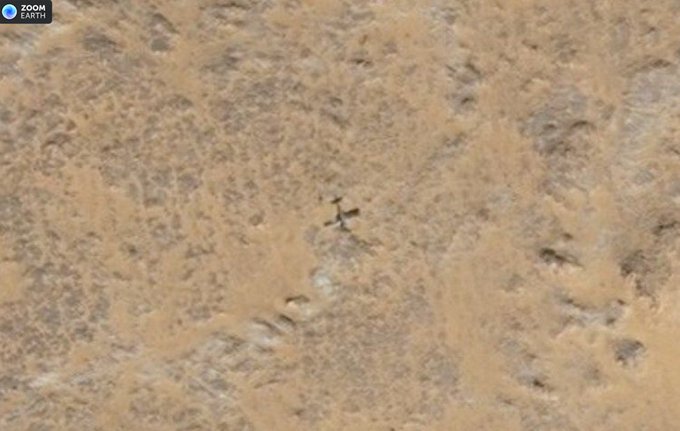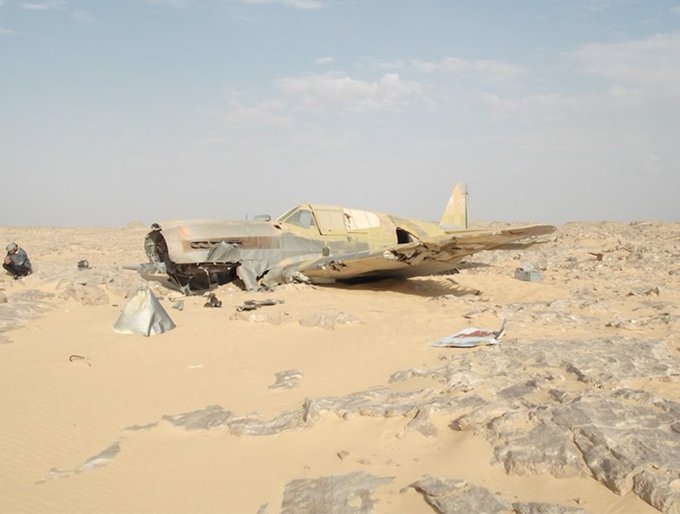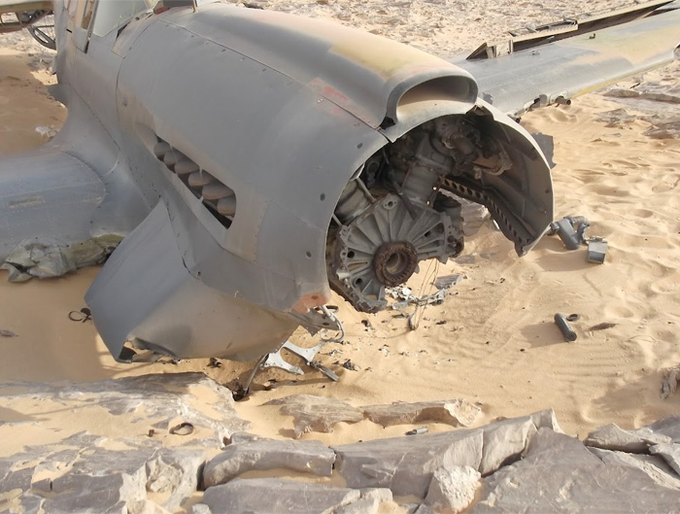Mysterious Things Found in the Desert

March 7, 2023
•11 min read
Lots of mysterious things have been found in the desert. Let's explore the most mysterious desert discoveries ever.
From the pyramids of Egypt to Area 51, deserts all over the world are filled with amazing, mysterious stuff. Considering deserts account for about a third of all land on Earth, it’s hardly surprising that new oddities are constantly being discovered or dug up.
But not every find is easy to make sense of, and in many cases, desert discoveries raise more questions than answers. With that in mind, let’s head into the extreme conditions of these arid wastelands, and explore some of the most mysterious desert discoveries ever made.10. The Marree Man
In 1998, a helicopter pilot flying over the South Australian Desert noticed a huge 2.5-mile-long image of a man carrying a spear. Around the same time, anonymous faxes were sent to local businesses informing them of the geoglyph’s existence.
The Marree Man, later named after the town closest to it, depicts an aboriginal hunter carrying a woomera, which is a type of throwing stick used by Aboriginal natives of Australia.Despite the cultural connection, the local Aboriginals deny any involvement, and initially perceived the geoglyph as a desecration of their land. To this day, no one knows who’s responsible for the mysterious piece of art, which is dug 14 inches deep into the Australian desert.Even though a 5,000 Australian Dollar reward has been offered for information that could help to identify the artist, or culprit, depending on how you look at things, no one’s come forward. However you look at it, considering GPS was in its infancy at the time of its construction, the feat is astounding.9. The Atacama Desert Whales
The Chilean Atacama Desert is one of the last places you’d expect to find forty whales, several dolphins and other sea mammals. Defying expectations, ‘Whale Hill’ is 131 feet above sea level and almost 2 miles from the sea.
8. Desert Disaster
In 2012, workers for a Polish oil company on an expedition in the Sahara Desert came across a British Royal Air Force fighter plane. On its own, this would be peculiar enough. But curiosity was propelled skywards when the plane was found to have crashed there almost 70 years prior, during World War 2.
Not visible on Google Earth but seen here on Zoom Earth- An incredible WW2 relic only discovered in 2012. A RAF Curtiss P-40 Kittyhawk fighter that went missing June 28, 1942. 1/5 #planespotting #avgeek #aviationdaily #aircraft #aviationlovers #aviation #milair

7. Lac de Gafsa
When it was discovered by shepherds during the hot 2014 summer, Lac de Gafsa in the Tunisian desert was an immediate tourist attraction. What made the lake so special was that it appeared overnight, seemingly out of nowhere, in a spot that had previously been arid desert.
Thought to be between 32 and 59 feet deep, the water started off a gorgeous blue, but quickly became green, as algae began to infest the lake. This algal growth indicated that the lake had become stagnant, making it a breeding ground for awful diseases like dengue and malaria.On top of this, the lake’s high concentration of phosphate and potential contamination from nearby mines mean it’s likely carcinogenic, and mildly radioactive. Due to the lack of a government-mandated ban on swimming there, locals ignored experts’ warnings and flocked to the water for a desert dip.6. Atacama "Alien" Skeleton
A bizarre skeleton was found in the Atacama Desert in Chile, in 2003. Its appearance sparked an ongoing debate, with one side asserting that the discovery is a partially-preserved human fetus, while the other side’s certain that the remains belong to an extraterrestrial visitor.
It measures only six inches tall, but the bones seemed to be as mature as those of a six to eight-year-old child. The long, angular skull and 10 ribs as opposed to the usual 12, only intensified interest. U.F.Ologists were obsessed for years, and several documentaries and investigations followed.A 2018 study led by Stanford professor Garry Nolan appeared to confirm that the ‘alien’ was in fact a fetal human female. Genetic analysis revealed that the skeleton possessed the standard, shared genetic indicators found in natives of the geographical area she was discovered in. She was afflicted with various developmental issues, including a rapid-aging bone disorder, which seemed to explain her tiny, perplexing frame. But the Atacama Skeleton also featured dozens of genetic mutations that had never before been recorded. Some take this as a sign that this extraterrestrial case remains open, but what do you think?5. Wheels Of The Middle East
These wheel-like structures, found in the Middle-Eastern desert from Jordan to Saudi Arabia, may be some of the oldest geoglyphs on Earth. Tests indicate that some could be up to 8,500 years old. While some of the structures seem geometrically arranged, and even line up to stretch towards the winter solstice sun, the various instances are far from uniform.
4. Nabta Playa Calendar Circle
Does the series of standing stones in the image below, found 500 miles south of Cairo in the Nubian Desert, seem familiar?
That’s because it’s a calendar circle, just like Stonehenge. Only, this one could be up to two thousand years older than England’s tourist hotspot. The 6,000-year-old site, found in the Nabta Playa basin, was first discovered in 1974. Its discovery included buried items like pottery fragments, fire-blackened hearths and the calendar circle, which is the only megalith of its kind known to exist within Egypt.But what were Neolithic nomads doing this far out in the desert? The answer lies in the Nabta Playa basin itself, which was once rich with water. The stones themselves align with the rising sun at the summer solstice, indicating a ceremonial or ritual purpose to the site.
3. The Empty Tomb
Egyptologists are no strangers to mummy-filled royal tombs. But professor Kent Weeks was left scratching his head when he discovered an expansive tomb in the Valley of Kings, with more than 100 rooms, seemingly empty.


2. The Kharga Spiders
Deep in the Western Egyptian desert, at the Kharga Oasis, can be found a series of mysterious carvings in the stone, dating from around four thousand to six thousand years ago. The art, pre-dating Ancient Egypt by as many as 3,000 years and found on a sheet of limestone, appears to depict spiders and their prey.
Experts suggest the carvings may have been a form of worship to hardy desert spiders, who basked in the scorching sun, in hopes of gaining some of their resilience to the unbearable heat.Depictions of spiders can be found in various ancient cultures, though no others of this kind have been seen in Egypt. Some argue that the carvings are not of spiders at all, and are instead a form of written language, whose meaning is lost to time. Or maybe someone just wanted to carry out the first ‘fake spider’ prank in history.Honorable Mention
Before we get to the hotly-debated number one desert mystery, it would be remiss not to mention an event that’d leave any desert traveler baffled, at least until they heard the explanation. In 2004, a flying saucer crash-landed in the Utah desert. What’s more, NASA released pictures to prove it.
Unfortunately, though, this had nothing to do with little green men. Instead, it was a sample return capsule from Genesis, a NASA craft tasked with collecting solar wind particles. When the craft returned from its three-year excursion, the parachutes designed to slow its descent never opened.NASA was forced to deploy helicopters to recover the Identified Falling Object, which was traveling at almost 25,000 mph. Luckily, much of its research was recovered. Though not a mystery for those in-the-know, the sight of it must’ve knocked any uninformed passers-by straight out of orbit.1. The Eye Of The Sahara
From the ground, the Eye of the Sahara, otherwise known as the Richat Structure seems like any other stretch of desert. From the sky, though, the phenomenon, nestled deep into the Sahara Desert, is a wonder. An enormous eye stares up from the sand, but it’s mostly only visible to Google Earth aficionados and astronauts.
The eye has been the subject of fierce debate over the years, with explanations ranging from the mundane to the fantastical. Originally, geologists assumed the eye to be a huge impact crater from an asteroid, but studies found no evidence of any extraterrestrial compounds. One recent theory, published in the Journal of African Earth Sciences asserts that the structure is a deeply-eroded geologic dome, formed more than 100 million years ago. Back then, the Saharan land mass rested on top of a churning layer of magma, which swelled to form a circular, raised dome. Precisely, the Earth had to deal with 25-mile-wide zits as it was growing up.




























